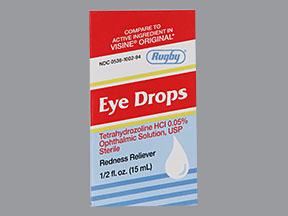Why is this medication prescribed?
Tetrahydrozoline ophthalmic is a medication primarily used to relieve eye redness and discomfort caused by irritation, such as from dust, smoke, or other environmental factors. It is a type of decongestant that works by constricting the blood vessels in the eyes, which reduces redness and swelling.
How should this medicine be used?
Here’s how you should use Tetrahydrozoline ophthalmic:
- Read Instructions: Always read and follow the instructions provided with the medication or those given by your healthcare provider.
- Wash Hands: Before applying the drops, wash your hands thoroughly to prevent introducing any bacteria into your eyes.
- Tilt Your Head: Tilt your head back slightly and pull down your lower eyelid to create a small pocket.
- Apply the Drops: Hold the dropper above the eye, and without touching the eye or eyelid, squeeze the prescribed number of drops into the pocket you created.
- Close Your Eyes: After applying the drops, gently close your eyes for a minute or so to allow the medication to spread evenly across the surface of the eye. Avoid blinking excessively or rubbing your eyes.
- Avoid Contamination: Make sure the tip of the dropper does not touch your eye, eyelid, or any other surface to prevent contamination.
- Repeat if Necessary: Follow the dosing instructions provided. Usually, Tetrahydrozoline ophthalmic is applied 1-2 times per day, but not more frequently than directed.
- Store Properly: Store the medication as directed, usually at room temperature, and keep it out of reach of children.
- Consult Your Healthcare Provider: If you experience persistent irritation, vision changes, or if the condition worsens, contact your healthcare provider. Also, consult them before using the medication if you have any pre-existing conditions like glaucoma or if you’re using other eye medications.
Using the medication as directed ensures that it will be effective and helps avoid potential side effects or complications.
Other uses for this medicine
Tetrahydrozoline ophthalmic is primarily used for relieving eye redness and irritation, but it can sometimes be used off-label for other minor eye discomforts under medical guidance.
What special precautions should I follow?
Special precautions include:
- Avoid Overuse: Do not use more frequently than directed to prevent rebound redness or worsening of symptoms.
- Check for Allergies: If you have a history of allergic reactions to similar medications, consult your healthcare provider before use.
- Consult Before Combining: Talk to your healthcare provider before using other eye drops or medications simultaneously.
- Avoid Contact Lenses: Remove contact lenses before applying and wait at least 15 minutes before reinserting them.
- Keep Clean: Ensure the dropper tip remains clean and doesn’t touch any surfaces to avoid contamination.
Always follow your healthcare provider’s advice for safe use. Always consult with your healthcare provider for personalized advice and follow their instructions carefully.
What special dietary instructions should I follow?
There are no specific dietary restrictions with Tetrahydrozoline ophthalmic.
What should I do if I forget a dose?
If you miss a dose, apply it as soon as you remember. If it’s almost time for your next dose, skip the missed dose and resume your regular schedule. Do not double up on doses.
What side effects can this medication cause?
Tetrahydrozoline ophthalmic can cause some side effects, although they are generally mild. Common side effects include:
- Temporary Eye Irritation: Such as burning, stinging, or itching right after application.
- Redness: In some cases, redness might worsen initially before improving.
- Dryness: Some users may experience dryness or a feeling of grit in the eyes.
Less common but more serious side effects can include:
- Severe Eye Pain: Persistent or intense pain in the eyes.
- Vision Changes: Blurred or decreased vision.
- Allergic Reactions: Symptoms such as rash, itching, swelling, or severe dizziness.
If you experience any of these more serious side effects, discontinue use and seek medical advice promptly.
What should I know about storage and disposal of this medication?
- Storage: Keep the medication at room temperature, away from direct sunlight and moisture. Do not freeze.
- Disposal: Dispose of unused or expired medication according to local regulations or pharmacy guidelines. Do not flush down the toilet.
In case of emergency/overdose
- Emergency: If you experience severe symptoms or an allergic reaction, seek emergency medical attention immediately.
- Overdose: In case of overdose or accidental ingestion, contact poison control or go to the nearest emergency room.
What other information should I know?
- Consultation: Always consult your healthcare provider before starting, stopping, or combining with other treatments.
- Precautions: Avoid using if you have certain pre-existing conditions like glaucoma without medical advice.
Always adhere to your healthcare provider’s recommendations and seek their advice if you have any questions or concerns about Tetrahydrozoline ophthalmic.


